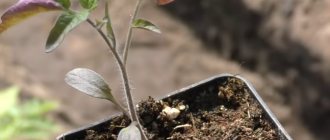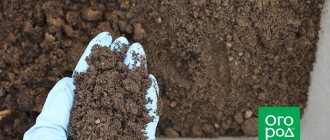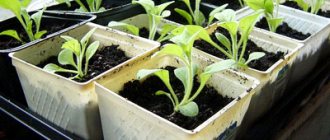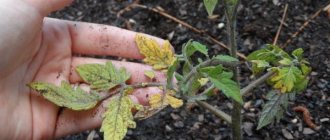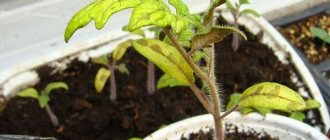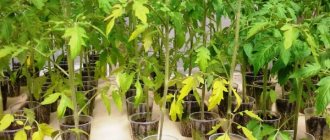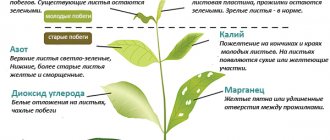Causes of wilting and poor growth of tomato seedlings. Methods of resuscitation. Preparations and recipes for feeding after picking.
Beginners and experienced gardeners are faced with a lot of nuances when growing seedlings at home. In addition to sowing, watering, care and feeding, each plant requires the attention and caring hands of a person.
During the period of intensive growth in open ground, tomatoes are resistant to changes in day and night temperatures and sunlight intensity. They are grateful for feeding and tying up the stems. However, from the moment of sowing tomato seeds to transplanting them into open ground, the gardener can expect weeks of caring for the young plants.
We are talking not only about picking, but also about treating diseases, organizing proper watering, temperature conditions, and light intensity. The main tasks are to preserve the seedlings, prevent them from withering, slowing growth and development. Let's talk more about this in the article.
Tomato seedlings do not grow - take action
When growing such a wonderful crop as tomatoes, gardeners face a number of difficulties; the most common problem is that tomato seedlings do not grow.
Tomato seedlings require compliance with certain conditions, for example, compliance with a special temperature regime. Immediately after the appearance of the first shoots, the boxes with seedlings are put into a cool place for a week; during the day the temperature should be 16-18 degrees C, at night - 13-15 degrees C.
Then the temperature can be increased to 20 degrees C during the day and 16 degrees C at night. The specified temperature regime is observed until the third true leaf appears on the tomato (approximately 30-35 days). During this time, the seedlings are watered 3 times at the root, the third time watering is carried out on the day of the picking, an hour before it starts. The recommended water temperature for irrigation should be 20 degrees C.
After the appearance of two true leaves, the seedlings must be sprayed daily (in the morning) with low-fat milk (1 glass per liter of water), this procedure is a prevention of viral diseases.
On the 12th day after picking, the seedlings are fed with nitrophoska (1 tablespoon per 10 liters of water). Watering is carried out sparingly as the soil dries.
If, under the specified conditions, the tomato seedlings do not grow or grow slowly, then the tomatoes can be fed with a growth stimulant, for example, sodium humate. The solution is diluted to a consistency reminiscent of tea in color and the tomatoes are fed 1 cup per plant.
Two weeks before planting, tomatoes must begin to be hardened by placing them on a balcony or under an open window. First for 2-3 hours then for the whole day. The hardening temperature should not fall below 8-10 degrees C.
OgorodSadovod.com
The seedlings have stopped growing
This phenomenon can be caused by two reasons:
- There is obvious stress - cold soil, air, irrigation water, as well as lack of nutrition. It is very important to follow all the rules of agricultural technology for each crop. Timely root feeding with macroelements (nitrogen, phosphorus, potassium) and foliar feeding with microelements, watering with settled water at a temperature not lower than +24 ° C will help correct the situation.
| By the way. The reason for the stunting of seedling growth may be acidic soil. Water the seedlings with calcium nitrate solution 2 times at the rate of 3 g per 3 liters of water. |
- If there was no decrease in temperature, then most likely there was a natural stop in growth after the picking. Injury to the axial root is a slight stress for the benefit of the future harvest. Seedlings grown without picking, although they enter the fruiting phase earlier, lose in terms of overall yield.
Picked plants stop growing. This is fine. It takes some time to restore the root system. For tomatoes it is 14 days, for peppers and eggplants it is 40 days. During this period, you should avoid feeding and stimulants - they can only aggravate stress. You should be patient, wait until the plant itself survives this difficult period, begins to grow, and then you can already use all the achievements of agrochemistry.
How to pick tomatoes?
When growing tomatoes in your garden, you may be faced with the question of whether you need to pick them.
Why pick tomatoes?
Correct picking of tomatoes helps to identify the strongest and most promising seedlings in order to later replant them for growing in more comfortable conditions. Weak and diseased seedlings are discarded.
How to pick tomatoes correctly?
Tomato seedlings can be plucked when the first two leaves appear on the seedlings. Earlier or, conversely, later (when 3-4 leaves have appeared) picking tomato seedlings can cause the tomatoes to take root poorly and be susceptible to frequent diseases.
The procedure for picking tomatoes is as follows:
- About two hours before picking, seedlings in containers must be watered. This way, clods of earth with roots will be better separated from the main mass. It is advisable not to touch the stem and leaves itself, since the temperature of human fingers is much higher than the temperature of seedlings. If you handle the stem with your hands, the plant may experience stress from such a high temperature. If necessary, it is better to use cloth gloves.
- Next, we prepare small pots and planting soil (a mixture of turf soil, peat and sand), the temperature of which should be kept at 20 degrees. To avoid damage to the seedlings, water the soil in the pots with a weak solution of potassium permanganate.
- Carefully remove the seedlings from the ground using a small wooden spatula, toothpick or any other small object.
- In a pot of soil, use your finger to make a small hole about 5 cm deep.
- Pour water into the hole.
- Slowly plant the seedling in the hole. The cotyledon leaves should be above the ground.
- After planting, compact the soil with your finger.
- We place the seedlings in a shaded place.
- We water once or twice a week.
As soon as the seedlings have taken root, the seedlings must be moved to a sunny place. It is also important to periodically ventilate the room to harden the tomatoes. The optimal ambient temperature is 15-18 degrees.
Feeding tomatoes after picking
After you decide to pick a tomato, you need to apply fertilizer. They will help strengthen the root system and promote more active growth of tomatoes.
Fertilize twice:
- 10-15 days after the pick;
- 2-3 weeks after the first feeding.
You can use any mineral complex fertilizer containing superphosphate, urea and potassium sulfate.
After fertilizing, be sure to water the seedlings to wash off the remaining fertilizer. After watering, lightly loosen the soil. As a result of properly carried out picking, you will receive tomato seedlings with a powerful root system, which means that later you will have beautiful and large tomatoes with excellent taste.
womanadvice.ru
How to feed frail tomato seedlings
If during the growing process the gardener made mistakes and the tomatoes grow poorly, this can be corrected. The seedlings begin to be illuminated and the watering regime is normalized. Special means will help invigorate the seedlings and stimulate growth.
Drugs
To accelerate the growth of seedlings, you can use the same preparations that were used for soaking seeds and spilling soil. The active substance, when it gets on plants, penetrates cells and accelerates their division.
It becomes easier for the tomato to absorb nutrients from the soil, and its growth accelerates.
- Epin extra. A phytohormone, which is diluted in boiled warm water for spraying seedlings (1 ampoule per 5 liters). Treatment is carried out no more than 2 times a month.
- Sodium humate. A humus fertilizer that is safe for plants and people and has a gentle effect on tomatoes, encouraging them to grow. For spraying, prepare a solution of 1.5 g of powder and 5 liters of warm water. Before use, the mixture is infused for about 2 hours. The frequency of treatments is 3 times a month.
- Kornevin. Root system growth stimulator. Used for watering tomatoes after transplanting. The working solution is made up of 1 g of powder and 1 liter of water. The transplanted plants are watered with Kornevin, spending 30 ml for each seedling.
Expert opinion
Stanislav Pavlovich
Gardener with 17 years of experience and our expert
Ask a Question
Important! Do not exceed the concentration of the drug in the working solution; you can burn the foliage.
How to grow tomato seedlings correctly
It's hard to find a person who doesn't like tomatoes. Of course, you can buy them in a store or at a market - fortunately, tomatoes are now sold all year round, but it’s still better to grow them yourself - such tomatoes are tastier, healthier, and more environmentally friendly. But often the desire to eat your own tomatoes comes up against ignorance, so to speak, of the technology for growing them. The first question is how to properly grow tomato seedlings.
A little about tomato seedlings
Seedlings are grown from tomato seeds planted in the soil and after a certain time the grown shoots are transplanted into open ground.
The question may arise - why grow seedlings at all? Isn't it easier to sow tomato seeds in the ground and wait for them to germinate? But in our rather cool climate this is basically impossible. And that is why you first need to grow seedlings, and then plant them in open ground.
The timing when you need to start growing it depends on the tomato variety:
- early and medium varieties of tomatoes - March or early April.
- late varieties - late January or February.
Preparing to grow seedlings
Before planting it, you need to consider the following:
- selection and preparation of a place for growing;
- selection and preparation of seeds;
- selection and preparation of containers and soil;
- water preparation and irrigation rules.
Growing space
Seedlings can be grown in residential premises (apartments, houses) or in a greenhouse. Most gardeners grow it on windowsills , so let's consider this option in detail.
If there were previously vases with flowers or pots with plants on the windowsill, then the window sill should be thoroughly washed using cleaning products. Plants can have various diseases that can infect young tomato shoots.
Another tip - tomato seedlings do not like being moved from place to place . Therefore, choose a permanent “place of residence” for the seedlings and do not touch them unless absolutely necessary.
Seeds for seedlings
In agriculture, everything starts with seeds, so it is very important to choose high-quality and proven varieties of seeds for planting that are most suitable for your climate zone. If you are new to the “tomato business,” then when choosing seeds, do not rely on chance, but consult with experienced gardeners or read relevant literature.
Next, you need to properly prepare the tomato seeds. To do this, the following steps are performed sequentially:
- Checking the quality of seeds . Place the seeds in a saline solution (50 grams of table salt per liter of water) and wait about 7 minutes. Seeds that float to the surface can be safely thrown away - these are bad, incomplete seeds and there will be no use from them. The remaining seeds should be thoroughly washed in clean water.
- Seed disinfection . It is recommended to disinfect purchased seeds with a solution of potassium permanganate (5 grams of dry potassium permanganate per 500 milliliters of water). Rinse the seeds in the prepared solution for 10–15 minutes, and then rinse them thoroughly with clean water.
- Additional processing . Soak the seeds for 3–4 hours in a soda solution (1 tablespoon per liter of water); at the end of the procedure, rinse the seeds thoroughly in running water.
- Enrichment of seeds with mineral fertilizers . To do this, the seeds are soaked for 24 hours in a solution containing a mixture of mineral fertilizers. At the end of the specified period, you need to transfer the seeds to a moistened cloth and germinate them in a warm place for at least another two days.
Container for seedlings
Tomato seeds are sown in one common container, which can be used as:
- wooden box;
- Plastic container;
- plastic box.
The container should have drainage holes that improve the supply of water and air to the soil. It is preferable to use plastic containers rather than wooden ones, in which microorganisms harmful to seedlings may appear.
To transplant seedlings (gardeners call this process picking), use disposable plastic cups. Before use, make two small drainage holes in the bottom of each cup.
It is advisable to disinfect all containers intended for growing seedlings and then rinse them with clean water.
Water for seedlings
There is a widespread belief among most gardeners that when growing seedlings, only melt water should be used . But, since it is difficult to find clean snow or ice in the city, it is better to prepare such water at home. This is quite simple to do: pour settled tap water into a plastic bottle and put it in the cold (on the balcony or in the freezer of the refrigerator). After most of the water has frozen, you need to pierce the bottle and drain the remaining water at the bottom. Wait about ten minutes and once again drain the water that has thawed during this time. There will be ice in the bottle, which, when melted, will turn into melt water.
If there is no opportunity or desire to do all this, then you can use simple tap water, standing at room temperature for 12–24 hours.
Soil for seedlings
The soil should be loose and highly saturated with nutrients. The following soil mixture compositions are quite suitable:
- humus and chernozem in a ratio of 2:1;
- chernozem, sand, soil for seedlings in a ratio of 1:1:1.
It is best to buy a soil mixture specially prepared for tomato seedlings in a store or market. You can, of course, prepare the ground yourself, but this is quite a troublesome and dirty job.
To prepare the soil directly for sowing seeds, you must:
- Fill the seedling container with dry soil mixture and water it with water (not cold, but at approximately room temperature).
- Wrap the container with damp soil in cling film and leave it like that for about a day. During this time, the entire soil will be evenly saturated with moisture.
Growing seedlings
Sowing seeds
The seeds are sown in rows, the row spacing is at least 3 cm. The seeds should be at least 2–2.5 cm apart from each other.
After completing all preparatory procedures, proceed to sowing the tomato seeds:
- Make 1–1.5 cm indentations with a match or toothpick and carefully place one seed in each hole. Fill the depressions with soil and moisten them with a sprayer, then wrap the container again with cling film.
- sowing of seeds should occur in the same place where the container with seedlings will be located. Please note that during planting, direct rays of the sun can damage the seeds.
Before and during the pick
Approximately a week after sowing, the first shoots should appear - which means you can already remove the cling film so that the seedlings have access to light (but without direct sunlight). During this period, it is necessary to periodically water the soil with a sprayer and maintain the air temperature in the room within 10 °C at night and 15 °C during the day. In winter, when daylight hours are short, it is recommended to provide additional lighting to the seedlings.
Two weeks after sowing, the first leaves should appear, which means it is already possible to pick the seedlings, that is, plant their sprouts in their own containers. During this period , it is necessary that the room has high humidity and a temperature of about 23 ° C - to ensure such conditions, place a bowl of water near the radiator. And don’t forget to water the soil (preferably with a sprayer).
After transplanting, you need to lightly squeeze the soil around the stem of the sprout and carefully water it with a sprayer.
After the pick
It is necessary to refrain from additional lighting for a period of up to 5 days after picking and avoid direct sunlight on the seedlings.
10 days after picking, the seedlings must be fed with mineral fertilizers for the first time, and after another two weeks - for the second time. It is very important not to forget how to properly water tomato seedlings during this period - watering should be regular and moderately abundant.
After about another 20 days, young tomato sprouts should be sprayed with an antifungal agent (5% solution of copper sulfate). At the same time, hardening at low temperatures begins. This must be done before planting seedlings in open ground. In urban conditions, hardening is usually carried out on the balcony - the main thing in this matter is to cover the seedlings at night so as not to freeze and protect them from direct sun during the day.
After another week, flower clusters should appear on the young shoots and, if this happens, the seedlings can be planted in open ground. Before planting, it must be watered with a weak solution of potassium permanganate (2 grams of potassium permanganate per 10 liters of water). The holes in the garden bed need to be treated in the same way.
From the moment the seedlings are planted in the garden beds, another stage of growing tomatoes begins. But this, as they say, is “a slightly different story.”
ogorod.guru
Reasons for pulling seedlings
First I will list the probable reasons for this phenomenon. As a rule, seedlings stretch:
- due to low light;
- too high temperature;
- excessive watering;
- improper feeding;
- thickened sowing.
In front of me on the table are crops of gatsania, viola, tagetes, salpiglossis and Chinese carnation. The age of these seedlings is from a week to two, but in any tray, except for the one with salpiglossis, elongation of seedlings has not yet been observed, and salpiglossis seedlings at the initial stage are traditionally prone to overgrowth. Now its seedlings are as thin as a hair, but under normal conditions in two weeks they will become thicker and stronger.
Chinese clove seeds
Lack of nutrients
If the seedlings do not develop, then most likely they lack nutrients. How to recognize a deficiency of a particular substance and eliminate the consequences?
With nitrogen deficiency, tomato seedlings are stunted; the stem becomes thinner; the leaves become smaller and turn pale.
With a lack of phosphorus, the underside of the leaves turns red-violet.
A lack of potassium is manifested by marginal yellowing of the leaves and their curling.
In the absence of magnesium in the substrate, the leaves become “marbled”.
Growth stops due to iron deficiency. The leaves lose their color saturation and turn yellow.
Treatment is the application of fertilizers with the appropriate composition. Why do tomatoes turn yellow? Chlorosis, which develops due to a lack of iron, is to blame. It is urgent to remove the seedlings from the light and apply iron-containing fertilizers on the leaves.
Do I need to pinch out seedlings?
Readers ask me if it is possible to pinch elongated plants. As long as the seedlings have only cotyledon leaves, pinching is out of the question, because you will leave a bare stem that will die over time.
- Cucumbers: diseases and their treatment
Until real leaves appear on the seedlings and they clearly begin to grow, you cannot pinch them. When the plants develop, pinching will help stimulate the development of lateral dormant buds located in the axils of the real leaves.
All the best.
Unsuccessful pick
Tomato seedlings stop growing after picking because
The plant was moved carelessly and the roots were severely damaged.
Before picking, the soil must be thoroughly watered. When the water is absorbed, dig up each tomato with a small spatula or finger and transfer it to a new place along with a lump of earth. The root system is practically not affected by such picking.
The roots of the tomatoes were bent.
The root system of tomatoes is long. Therefore, when picking, you need to make a deep hole so that the roots fit freely in it.
The roots are poorly compressed, which is why air cavities have formed around them.
When seedlings are transferred together with a clod of earth, this problem rarely arises. To prevent the formation of air cavities, the soil around the plants is carefully compacted in layers.
The leaves of the seedlings became hard, changed color, spots appeared on the leaves, the growing point died
— Excess of fertilizers . The prepared soil already contains the fertilizers necessary for seed germination; you need to be very careful when applying fertilizers. Seedlings may become poisoned. If such a situation arises, washing the soil with a large amount of water will help, provided that the water should drain freely. Or replanting into new soil.
Sea sand was used as one of the components in the soil mixture , the salts of which caused poisoning of the roots. In this case, you should change the soil and replant the remaining plants and wash the roots.
- Lack of moisture.
Improper care
Errors in care can explain why tomatoes wither, become smaller and do not grow.
1. The seedlings were flooded, so the roots were deprived of oxygen and suffocated.
You urgently need to clean the drainage holes at the bottom of the box, try to loosen the top layer of soil with a thin wooden stick (if the seedlings are still very small and sit close to each other, it is better not to do this). If there is no drainage in the container, healthy specimens are transplanted.
2. The substrate did not suit the tomatoes.
We water it correctly, feed it on time, the place is chosen well, but the seedlings still don’t grow. The soil is most likely not suitable for it. In this case, you will have to change the soil.
If the seedlings stretch
Growth regulators
You can stop the growth of seedlings with the help of drugs that stop linear development such as Tour, Stabilan and Atlet, which I used at one time. Under their influence, plants begin to develop in width.
But I would not recommend using these drugs at an early stage of seedling development, because the slightest error in dosage can cause the seedlings to burn. And even if everything goes well, you can slow down the growth of seedlings so much that they stop developing altogether. Growth regulators are quite dangerous and require very careful handling.
Powder
If the seedlings have stretched out, you can sprinkle soil between the rows to cover the lower part of the stems of the seedlings, or during picking, deepen the seedlings to the cotyledon leaves.
True, not all plants have the ability to form additional roots, like tomatoes or petunia, but in any case the seedlings will level out, will not fall over, and it will be easier for you to work with them in the future. The main thing is to never cover the growing point with soil, otherwise the seedlings will stop growing.
Also try to change the conditions in which the seedlings are kept so that they do not begin to stretch out again.
The seedlings got sick
Most often, the growth of tomatoes is stopped by the following diseases:
Rot.
Develops under overflow, low ambient and substrate temperatures. Diseased seedlings cannot be saved. It is necessary to quickly transplant healthy seedlings into new soil. Before transplanting, treat the roots with potassium permanganate.
Blackleg.
A fungal disease that affects weak seedlings. The development of blackleg is promoted by waterlogging of the soil, dense planting, lack of lighting, and heat. When the disease occurs, the base of the stem turns black, softens and becomes thinner. The seedlings die.
You can save the plant only at the very beginning of the disease - water it with potassium permanganate, dive more rarely, loosen the soil.
It is best to prevent seedling diseases.
1) Before sowing, calcine the soil mixture and spill it with a solution of potassium manganese.
2) Pour boiling water over the boxes or soak them in potassium permanganate.
3) Disinfect and dry the seeds.
4) Plant tomatoes sparingly so that they grow freely without crowding each other.
5) Water the seedlings abundantly, but rarely. The substrate inside must remain moist, and the surface layer must have time to dry.
6) To prevent rotting of the root collar, you can add a little sand to the box with seedlings.
7) Place seedlings on well-lit window sills and ventilate the room more often.
If you follow these simple recommendations, you can get strong seedlings. And subsequently - a good harvest.
ProPochemu.ru
The root system does not develop
The root system develops slowly with a lack of light and dense plantings. The duration of daylight should be at least 14-16 hours. Electric phytolamps are used for additional illumination. Moving the containers apart will help prevent dense planting; the leaves of different plants should not touch.
After germination of the second and third leaves, the seedlings are transplanted into separate containers. The root system receives better conditions for development. Damaged plants must be discarded. Picking the main stem by 1/3 will help increase the number of lateral roots.
Important! It is recommended to treat pinched roots with potassium permanganate; soaking in a growth stimulator will also help speed up growth.
When choosing containers for seedlings, you should give preference to models with drainage holes. Dimensions also play an important role; they should be 12-17 cm in width and height.
The reason for the poor development of the root system is considered to be an excess of moisture, which leads to an increase in the concentration of carbon dioxide. Oxygen starvation is very dangerous; it can lead to the death of the plant.
The quality of the soil also plays an important role in the development of seedlings. Peat is used to loosen clay soil. When treating acidified soil, dolomite flour and lime are used. The optimal acidity level for roots is considered to be 6 pH.
Soil and lighting play a very important role in the good growth and development of seedlings.
Tomato seedlings without picking
Picking or picking is the transplantation of young plants to another place. This method is widely used when growing seedlings. Tomatoes tolerate this procedure quite well, and some gardeners replant young shoots twice or even three times as they grow. The time for the first picking comes when the plants have their first true leaves, approximately 7-10 days after germination.
Previously, following the general opinion that picking is necessary, even necessary and brings great benefits to the seedlings, I also transplanted small tomato sprouts from a common box into separate cups. It should be noted that this work is not difficult, but it never brought me much joy, probably too painstaking for me. So one day I tried to grow tomato and pepper seedlings without picking at all. It turned out no worse, and since then I haven’t been picking for many years, to my satisfaction.
Tomato seedlings without picking
I grow seedlings mainly in cups. And to avoid picking, I sow both tomatoes and peppers directly into cups. Moreover, I fill the containers intended for seedlings of tomatoes to a third, and for peppers - almost completely.
Plastic cups for seedlings
Before sowing tomatoes, I fill the cups one-third full with soil.
For planting, I use seeds that I have prepared myself; I always have plenty of them, so I sow at least 3-5 seeds in each glass and don’t skimp.
I sow 3-5 seeds in a glass
When tomato shoots appear, I thin them out twice, and I don’t pull out unnecessary plants, but carefully cut them off with scissors. At first I leave two sprouts in each glass, and when they grow up, get stronger and throw out 3-4 true leaves, then I leave only one of the strongest and healthiest plants.
Tomato seedlings shoots
I leave one plant in a glass
During thinning, if necessary, excess seedlings can, of course, be transplanted into other containers.
As the seedlings grow, I gradually add the prepared soil to the cups. To avoid an unpleasant disease - “black leg”, I hill up young plants a little. After adding soil, the tomatoes quickly grow additional roots, grow actively and practically do not suffer from anything. Peppers do not stretch as much as tomatoes, and you do not need to add a lot of soil to their cups.
Sometimes I grow some of the seedlings directly in boxes.
Tomato seedlings in a box
In this case, I also fill the containers first only a third, and then, as the tomatoes grow, I add soil to the required level - 12-15 cm. I put partitions between the plants in the boxes, so the roots do not intertwine and are not damaged during planting. This means that the adaptation of seedlings after planting in open ground goes very well.
A rigorous selection of the best plants and good care allows us to obtain powerful and strong seedlings of both tomatoes and peppers by the time of planting.
Tomato seedlings
Sweet pepper seedlings
Plants practically never fall out; they do not even wither and immediately begin to actively grow.
I, of course, do not urge everyone to give up picking seedlings completely, but simply draw attention to the fact that good seedlings can be grown without this procedure. blog Delicious Vegetable Garden Author: Victor Gardener
